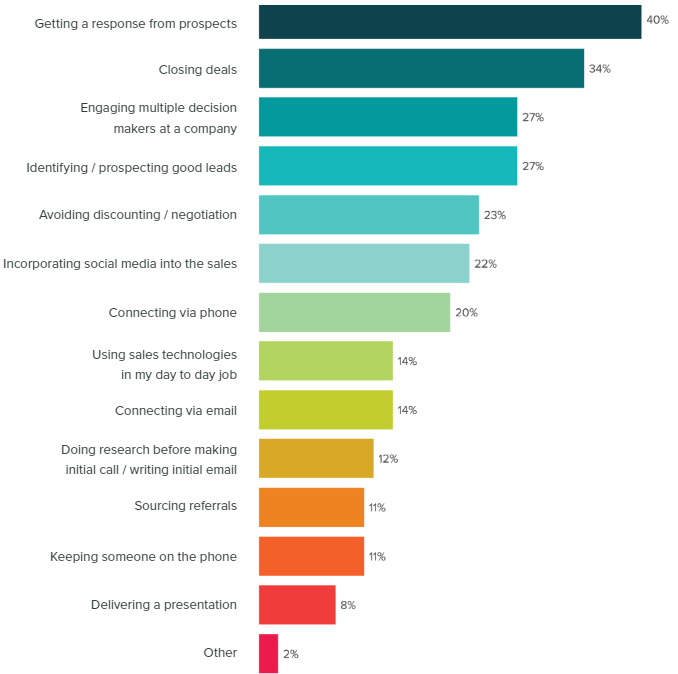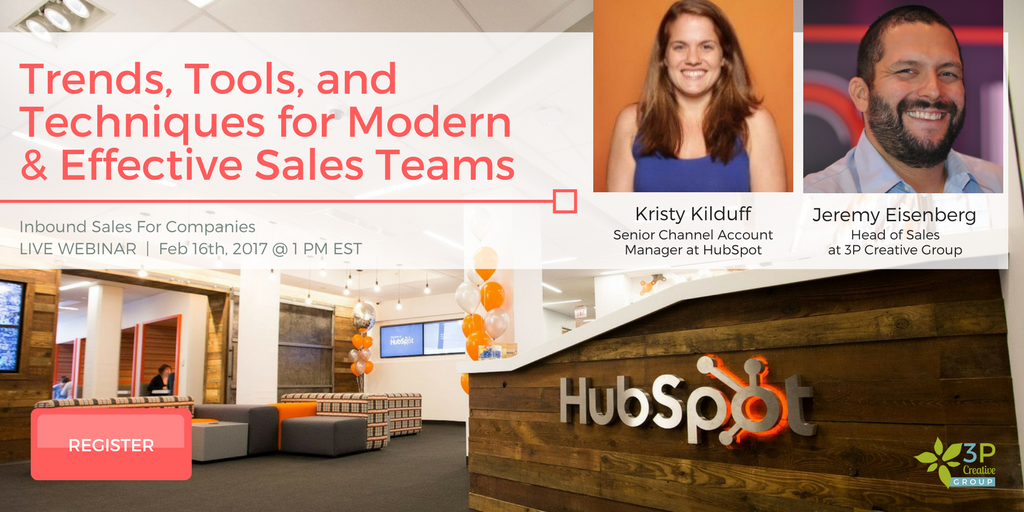Top 5 Challenges Modern Sales Teams Struggle With & How To Tackle Them
When I started my internship at one of the largest software companies in the world back in 2000, my manager gave me a tour of the office facilities. As we passed through the floors with the salespeople's offices, you could feel the tension in the air. He explained to me that enterprise software sales were undergoing a drastic change. Until a short while ago, the salespeople simply waited for the phone to ring to sell software.
However, that was changing. The market was getting crowded with newcomers and old rivals. Now the sales team had to reach out to prospects proactively! Now, almost two decades later, (software) sales are undergoing another massive shift. One of the biggest indications of this change is how much salespeople are struggling with a set of challenges.
Today's Buyers Ignore Pushy Salespeople
Did you ever hear the old fashion sales mantra "ABC - Always Be Closing"?
Well, that is history. Modern buyers are more educated and empowered as they are much more proactive about gathering information than they were ten years ago.
In fact, studies have shown that prospects go through most of the sales process (up to 60-70%) by themselves, with the help of information they find online as well as through input from peers, family, and friends — without ever contacting a salesperson.
So salespeople need to adapt. The new motto is "ABH - Always be Helpful" as Dharmesh Shah and Brian Halligan so effectively illustrated recently at Inbound 2016 during their keynote.
But even a few years later, not everyone has gotten the message yet: Prospects are still bombarded with spam emails, junk mail, and robot calls during dinnertime. For salespeople that want to add value and be trusted advisors, it becomes harder and harder to stand out.
According to the State of Inbound Report 2016, 40% of sales reps name getting a response from a prospect as their biggest challenge in 2016 - even before closing deals or the struggle to engage multiple decision-makers in a company. Below are the biggest challenges that modern sales teams faced in 2017 - and they are not likely to change much in 2017.

Source: HubSpot's State of Inbound Report 2016
Want more stats like these? Download the full report here.
If you are facing any of these challenges above, let's dive into how to tackle them effectively.
Getting A Response From Prospects
You already know how hard it is to get someone to respond to an email, voicemail or pick up the phone when you are calling them. With sophisticated technologies such as spam filters and caller ID, it has become very easy to filter out whom we want to talk to and whom we want to ignore.
Personally, I receive on a daily basis half a dozen "personalized" emails offering services or partnerships. I also get hit with robocalls or unsolicited sales calls daily, sometimes five a day.
The problem is, in most B2B industries, there is no chance of turning a prospect into a customer without having a conversation. Especially in B2B technology, sales cycles are very intense and take at least 6-12 months.
So, how can you get through to your prospect and initiate a conversation? Here are some tips:
- Take the time to research them and their company.
- Don't pitch! Reach out to be helpful. Do them a favor. While getting my attention on LinkedIn is more likely to get a response, or at least I will read the message, a pure out of the blue offer/sales pitch is not the way to do it.
- Try different channels: try to connect on LinkedIn, email them, and of course call. You might even want to follow them on social media and subscribe to their blog.
- Be a real person. It goes without saying that you should use your real work email address instead of sales@ or a Gmail address. Include your full name, title, and company in the signature. You can also link to your best piece of content and your Twitter or LinkedIn profile. For extra bonus points, help them put a face to the email address and name by including a picture in your signature.
In other words: Treat them like you want to be treated.
Closing More Deals
Obviously, closing more deals is always going to be high on the list. Because that means more revenue.
But that does not mean you should go out there and pitch to everyone who is willing to listen. Too many salespeople go into pitch mode as soon as they get a person on the phone. This is their one chance, right? The person has finally picked up the phone, and they have to get through their script before the person hangs upon them. Wrong.
Everyone goes through what is called a buyer's journey. In the early phases of the decision-making process, the prospect researches a problem or opportunity. Once they have given it a name, potential buyers will dig deeper to find possible solution approaches, before narrowing down that list and purchasing one.
If you as a salesperson reach out and pitch them your solution in the early research process, you are disqualifying yourself already as a pushy salesperson they don't want to talk to anymore. But that doesn't mean you shouldn't reach out. Offer some tips and helpful advice that is actually valuable for them. Start qualifying them in the conversation for budget, authority, and need. If they are unqualified, make a note in your CRM and move them over to marketing to get enrolled in a marketing workflow that will nurture them further.
If circumstances change and they do become eligible in the future, this method will keep you top of mind and draw them back to you. For instance, if you see a trigger event (e.g., they revisit product pages or pricing pages on your website), you can reconnect and go for the close. Instead of racking up many losses for a couple of wins, forgo the early wins for a steady stream of wins.
Engaging Multiple Decision Makers
You get an email from marketing with a newly assigned lead. This lead is super hot, all over your website, downloaded a few resources, and filled out the sales consult form. Slam dunk! Right? You look at their LinkedIn profile, and they are a senior manager. Excellent! You get in touch with the lead; he checks all the right boxes, and you give it all you got. He loves the plan you laid out for him.
But then he says, he will need approval from his boss. And his CFO and CTO also need to approve this. You need to do this again to his boss, who will then need to get approval from the CFO & CTO. Oh, and to get that approval, you will have to present to them as well.
Now, this is tricky. He could take all the information to the executive management himself, and they talk internally. But at this point, the sale is out of your hands. Naturally, they will have a different set of objections - something you might not have addressed yet in previous conversations. But you are not able to address them now because you are not part of the conversation. Your lead might come back to you with some follow-up questions, but without proper context of why these issues are being raised, it will be difficult to steer back in the right direction. Even if they are on board, most of the time, you will find they have different goals for the project and they are not entirely bought in.
The better way to deal with this situation is to offer to discuss the plan with everyone involved. You want to get to the point where everyone sits on one side of the table instead of sitting across from each other - so to speak.
Start at the beginning and recap all the goals, plans, challenges, and timelines you have so far discussed with your original contact. Confirm these and don't assume anything. Then tie these to the strategy that you have previously discussed - but only if all the previous data points stay the same. If something drastically changes, be flexible and adjust the plan accordingly.
Identifying/Prospecting Good Leads
Almost every third salesperson names 'identifying and prospecting good-quality leads' as their primary challenge. Since the average salesperson prospects for 6.25 hours to set one appointment, you need to be sure you are spending that time wisely.
First, you will need to start by identifying high-quality leads. Start by defining what that even means. For example, if you are a software company that sells on a per-seat basis and you have a sweet spot at 5,000-25,000 users, then the number of employees could be a possible criterion for identifying your ideal leads.
For leads coming through your inbound marketing channel, you can look at what resources they have downloaded so far, what pages they visited, how engaged they are with your site, which emails they opened, and much more.
Once you've reached out, make sure to jot down a note or record a call in your CRM. Adding detailed notes to the CRM after satisfactory and unsuccessful attempts can help to discern patterns. Using these patterns you can then create lists and views that show you the prospects that are ready to buy. Also, lead scoring can help you identify which of all these prospects are worth talking to.
 But even the best inbound marketing websites only convert about 5% of traffic into leads. On average, that usually leaves sales to come up with the majority of leads themselves.
But even the best inbound marketing websites only convert about 5% of traffic into leads. On average, that usually leaves sales to come up with the majority of leads themselves.
By using technology (e.g., HubSpot's Prospecting Tool, Lead Forensics) you can see which companies have visited your site but haven't filled out any forms to identify themselves.
From there you can research the company on LinkedIn and search for the most likely person to have come to your site. Sending a message through LinkedIn Sales Navigator will probably get their attention better than a direct email, which again, using technology like the HubSpot CRM can guess it based on other available data.
Avoiding Discounting/Negotiations
As a German, negotiating and discounting always made me very uncomfortable. It makes me think of sleazy car salesmen.
When I started my agency, I sold very differently. I basically found out what the client's problem and budget were and then backed into a solution. However, this always ended in price negotiations. Since I had honestly budgeted for the plan I was proposing, I had not built in an additional buffer for possible discounts.
I still don't build in extra buffers - but I changed my sales process dramatically: I qualify a lot more and better than ever before. I spend more time going through the initial discovery process, digging deeper to discover underlying problems, and establishing myself as a trusted advisor because pushing my clients to a solution just to close the deal will not be a win for both of us long-term.
Usually, I present three options - the only difference is how fast they will reach their goal. They make the choice. If my client understands the value of my agency and the proposed solution I bring to the table, there is less of a chance that the deal will not happen because we get caught up in price negotiations.
As a salesman working on an inbound lead, you show them the advantages of achieving their goals using your service AND the negative consequences of what happens if they don't meet their goals. At this point, costs shouldn't be much of a factor anymore. And if there is still some pushback to the price, a small discount here to close the deal instead of dragging it out is the way to go.
Over the next few weeks, we are going to tackle the rest of the challenges - so stay tuned. And if you want to learn how to become a better inbound salesperson, join us for our webinar with one of the best sales executives that HubSpot has!
Share this
You May Also Like
These Related Stories

How To Get 5x More Meetings Booked By Using Video Email In Your Inbound Sales Process

What Is Assignment Selling & How Can Your Get Started Today?

.png?width=250&height=125&name=TrustBuilderLogoWhiteTranspBackgr(250x125%20px).png)


No Comments Yet
Let us know what you think